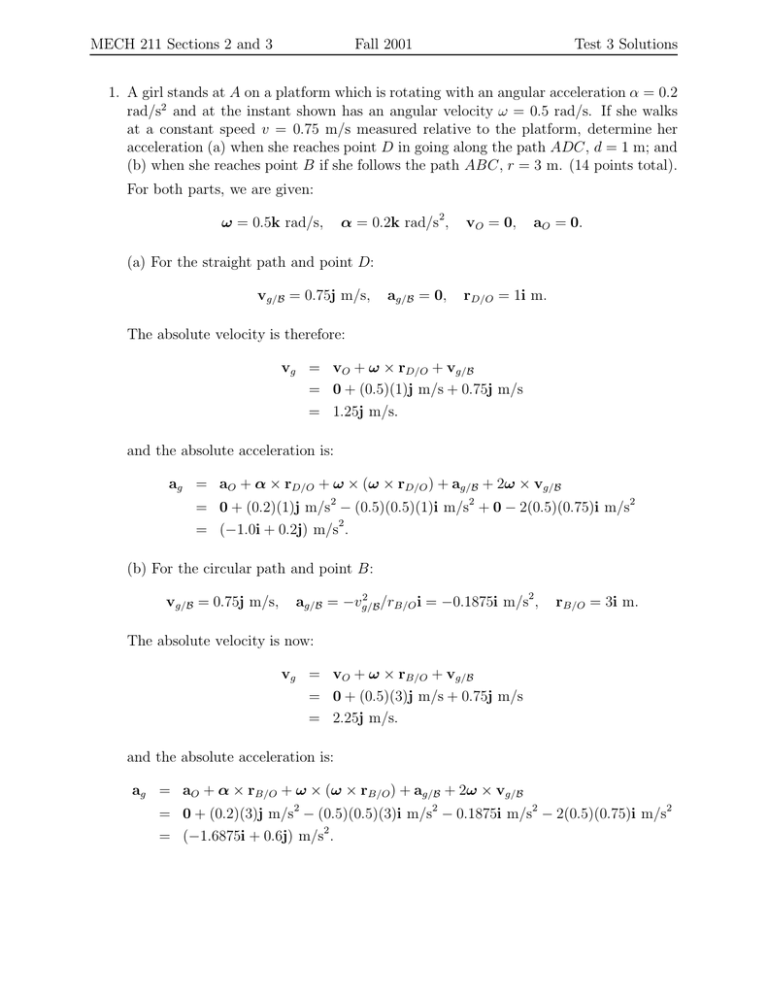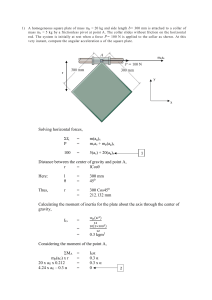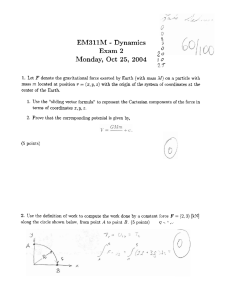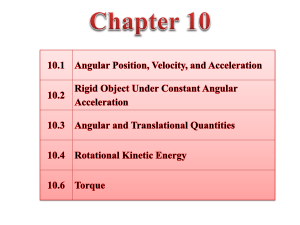MECH 211 Sections 2 and 3 Fall 2001 Test 3 Solutions 1. A girl
advertisement

MECH 211 Sections 2 and 3 Fall 2001 Test 3 Solutions 1. A girl stands at A on a platform which is rotating with an angular acceleration α = 0.2 rad/s2 and at the instant shown has an angular velocity ω = 0.5 rad/s. If she walks at a constant speed v = 0.75 m/s measured relative to the platform, determine her acceleration (a) when she reaches point D in going along the path ADC, d = 1 m; and (b) when she reaches point B if she follows the path ABC, r = 3 m. (14 points total). For both parts, we are given: ω = 0.5k rad/s, α = 0.2k rad/s2, vO = 0, aO = 0. (a) For the straight path and point D: vg/B = 0.75j m/s, ag/B = 0, rD/O = 1i m. The absolute velocity is therefore: vg = vO + ω × rD/O + vg/B = 0 + (0.5)(1)j m/s + 0.75j m/s = 1.25j m/s. and the absolute acceleration is: ag = aO + α × rD/O + ω × (ω × rD/O ) + ag/B + 2ω × vg/B = 0 + (0.2)(1)j m/s2 − (0.5)(0.5)(1)i m/s2 + 0 − 2(0.5)(0.75)i m/s2 2 = (−1.0i + 0.2j) m/s . (b) For the circular path and point B: vg/B = 0.75j m/s, 2 ag/B = −vg/B /rB/O i = −0.1875i m/s2 , rB/O = 3i m. The absolute velocity is now: vg = vO + ω × rB/O + vg/B = 0 + (0.5)(3)j m/s + 0.75j m/s = 2.25j m/s. and the absolute acceleration is: ag = aO + α × rB/O + ω × (ω × rB/O) + ag/B + 2ω × vg/B = 0 + (0.2)(3)j m/s2 − (0.5)(0.5)(3)i m/s2 − 0.1875i m/s2 − 2(0.5)(0.75)i m/s2 = (−1.6875i + 0.6j) m/s2 . MECH 211 Sections 2 and 3 Fall 2001 Test 3 Solutions 2. The 15-lb disk rests on the 5-lb plate. A cord is wrapped around the periphery of the disk and attached to the wall at B. If a torque M = 40 lb · ft is applied to the disk, determine the angular acceleration of the disk and the time needed for the end C of the plate to travel 3 ft and strike the wall. The disk does not slip on the plate and the surface at D is smooth. Neglect the mass of the cord. (18 points total). The FBD and MAD of the disk and the plate can be drawn as: T R M Iα m1a1 m1g F N1 N1 F m2a2 m2g N2 Summing the moments around A for the disk, and the horizontal forces for the plate, we obtain: ¯ + m1ā1 R, MA = M − F · 2R = Iα Fx = F = m2ā2 . Because of the cord, the disk undergoes instantaneous angular motion about A, and therefore ā1 = αR. Since there is no slipping on the plate, we also conclude that ā2 = α · 2R. Substituting these kinematic relations into the FMA equations above, we obtain two equations for two unknowns F and α: F = m2α · 2R, 1 m1R2 α + m1α · R2 , M − m2 α · 4R2 = 2 M = (4m2 + 1.5m1 )R2 α. The angular acceleration of the disk can be now computed as: M , (4m2 + 1.5m1 )R2 40 · 32.2 , = (4 · 4 + 1.5 · 15)1.252 = 19.396 rad/s2 . α = The linear acceleration of the plate is therefore constant at: 2 ā2 = α · 2R = 19.396 · 2 · 1.25 = 48.489 ft/s . MECH 211 Sections 2 and 3 Fall 2001 Test 3 Solutions Under constant acceleration and starting from rest, the time needed to travel the 3 ft distance is: 2s = 0.3518 s. t= ā2 3. The collar B has a mass of 3 kg and may slide freely on rod OA, which in turn may rotate freely in the horizontal plane. The assembly is rotating with an angular velocity ω = 1.8 rad/s when a spring located between A and B is released, projecting the collar along the rod with an initial relative speed vr = 1.5 m/s. Knowing that the moment of inertia about O of the rod and spring is 0.35 kg · m2, determine (a) the minimum distance between the collar and point O in the ensuing motion, (b) the corresponding angular velocity of the assembly. (18 points total). Just after the collar is released (state 1), the velocity of the collar is due to the angular motion of the assembly and the radial motion of the collar along the rod. At the minimum distance from O (state 2), the collar has stopped moving along the rod and its velocity is only due to the angular motion of the assembly. The momentum diagrams for these two states are shown below, with unknowns r2 and ω2 to be determined. Iω1 m(v1)r O m(v1)θ B A r1 Iω2 O m(v2)θ B A r2 Here, (v1)r = 1.5 m/s and (v1)θ = 0.5 · 1.8 = 0.9 m/s, and (v2)r = 0 m/s and (v2)θ = r2 ω2 . Noticing that the collar is free-sliding, and that the normal reactions at the collar do not do any net work on the assembly, we conclude that the kinetic energy of the assembly is conserved between states 1 and 2. Noticing also that there is no moment of external forces about the axis of rotation, we conclude that the angular momentum about that axis is also conserved. The kinetic energy T1 and the angular momentum h1 can be computed as: T1 = = h1 = = = = 1 2 1 2 Iω + mv 2 1 2 1 1 1 · 0.35 · 1.82 + · 3 · (1.52 + 0.92 ) 2 2 0.567 + 4.59 = 5.157 Nm, Iω1 + m(v1)θ r1 0.35 · 1.8 + 3 · 0.9 · 0.5 0.63 + 1.35 = 1.98 Nms. MECH 211 Sections 2 and 3 Fall 2001 Test 3 Solutions The kinetic energy T2 and the angular momentum h2 at state 2 can be computed as: T2 = = h2 = = = = 1 2 1 Iω2 + m(v2)2θ 2 2 1 1 · 0.35 · ω22 + · 3 · ω22 r22 2 2 (0.175 + 1.5r22 )ω22 = T1 , Iω2 + m(v2)θ r2 0.35 · ω2 + 3 · ω2 r22 (0.35 + 3r22 )ω2 = h1 . Substituting ω2 = h1 /(0.35 + 3r22 ) into the first equation above yields: r22 = − 0.35 , 3 1 2 h /T1 2 1 and r2 = 100.17 mm and ω2 = 5.209 rad/s.







